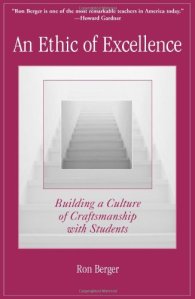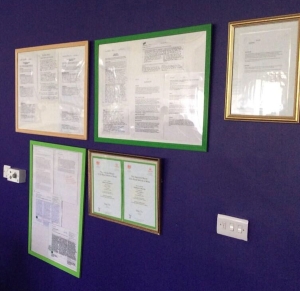We recently held the first in a series of voluntary curriculum conferences for mid-leaders to share their ideas about what might influence the design of our new post-levels curriculum.
Ideas that were shared during our first meeting:
- Designing a new English curriculum and post-levels assessment system from scratch (which you can read all about here)
- An Ethic of Excellence
- Using cognitive science to inform curriculum design
- Assessing without levels
For those of us that have already read ‘An Ethic of Excellence’ by Ron Berger, I’m sure most of us would agree on the deep and lasting impression it left upon us. For many of us, myself included, it has had a transformational effect on our work as teachers and school leaders.
Here, Head of Performing Arts Laura Jackson, shares her thoughts on the book and how it has influenced her thinking.
“It’s not a quick fix, it’s a way of life”
Ron Berger was an American Elementary School teacher . He was a craftsman, a carpenter by trade. He believes that “work of excellence is transformational. Once a student sees that he or she is capable of excellence, that student is never quite the same.”
An Ethic of Excellence
The book is written as a personal account of his findings, more like a story than an academic style book. In it he talks about the culture he has embedded in his own school and then in others as a consultant – that excellence cannot be achieved first time.
An Archiver of Excellence
Berger collects student work for his portfolio which has been built up over many years. The sharing of student work for the purposes of modelling and critique is central to his teaching repertoire. Archived work is shared with students. It shows development and progression – from first draft to “excellence”. Students spend time discussing the work of others and receiving critique on their own.
We were then treated to this, now legendary video of Ron Berger in action. It demonstrates the power of archived work in supporting students to achieve excellence, through the process of critique and re-drafting.
A School Culture of Excellence
The culture we create rests in our community – “in every effective school I’ve seen has a strong sense of community….staff and students in all these settings feel that they are part of something – that they belong.”
Positive Peer Pressure is used to create a safe learning environment, where striving for excellence is encouraged. Here, the positive critical feedback outlined above is crucial in achieving this.
Bigger is better? WE ARE LUCKY! “in a small school students and staff are highly accountable – it’s hard for the students to fall through the cracks” this is a privilege for us – we can make a bigger difference!
Work of Excellence
“We can’t first build up self-esteem and then focus on their work. It is through their own work that their self-esteem will grow.”
Project based learning is at the heart of the curriculum. The curriculum is “thematic” containing multidisciplinary themes over weeks and even months. High quality projects are celebrated everywhere so that the ethic, understanding and motivation are there right from the start.
Literacy and numeracy are built in throughout the curriculum – from basic to higher order skills. Work completed is genuine, of integrity and requires students to carry out their own research.
Assessment is continuous and used to build stronger students. Multiple drafts of work are the norm. Critique is used prior to each new draft, which must be:
- Kind – safety
- Specific – no wasting time
- Helpful – to help the individual not the critic
“Students need to know from the outset that quality means rethinking, reworking, and polishing. They need to know that they will be celebrated, not ridiculed, for going back to the drawing board.”
At the end of the year all student work is presented to a panel and made public through exhibitions or performances. Work is recorded to show the next intake what is expected in a year. Deadlines must be met – positive pressure is used throughout to ensure excellence.
Teaching of Excellence
The critique process doesn’t just apply to students, however. Teachers also critique each other’s work, and are expected to present and explain strategies that might be recommended. Teaching is seen as a craft – and with ‘expert’ status requiring as much as 10000 hours, feedback on practice is welcome and supports improvement. Relationships are seen as central to getting the best out of each other.
“Teaching isn’t about papers and pencils, it’s about relationships”.
Building strong relationships makes it much easier to ask ourselves and each other the fundamental question:
“How do we make the work stronger?”
Impact
To finish, Laura shared some of the ways in which the book has already impacted on her practice:
- Critique – first draft listening marked by students and re-written. This may take time away from “music” but when doing a similar task for the first time several weeks later, there was a marked improvement in first drafts.
- Excellence – Displaying the work for others to see, collecting a portfolio of “excellence” as a hard copy and a visual file to show students and staff.
- Adding context / value – Year 9 “showcase” performance – showing their best examples of performance work, Year 7 “Creative Arts Celebration Evening”
- Collecting examples of excellent work, evidence of excellent performances and practice work to display. Once it’s set up it is easy to update and develop.
An Ethic of Excellence, by Ron Berger is available from our Teaching and Learning library




Reblogged this on Excellence & Growth Schools Network.